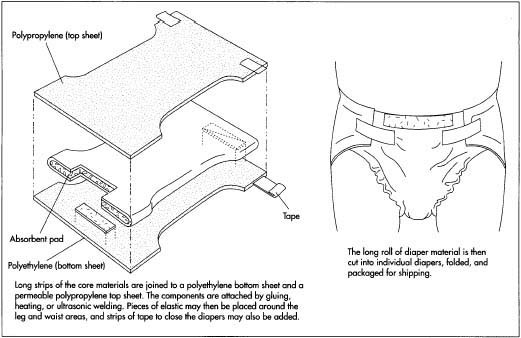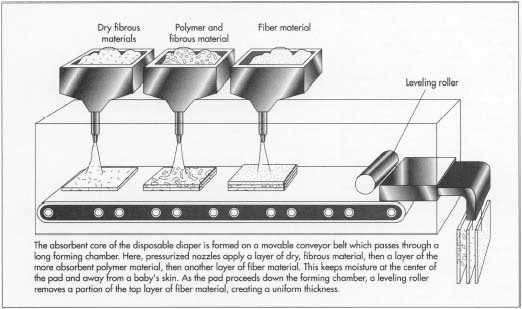Disposable diaper manufacture is a high technology field which has shown much innovation over the last few decades. And is the fastest growing sector of the nonwovens industry. Nonetheless, there are still a number of areas which require additional improvement. One such area is that of leakage reduction. It is likely that manufacturers will develop improved elastic bands to hold the waist more tightly without causing discomfort.
It is also likely that current concern regarding the role of disposable diapers in landfills will impact manufacturing and formulation. This concern may to lead to the development of diapers which are less bulky and more biodegradable.
A disposable diaper consists of an absorbent pad sandwiched between two sheets of nonwoven fabric. The pad is specially designed to absorb and retain body fluids, and the nonwoven fabric gives the diaper its' shape and helps prevent leakage. These diapers are made by a multi-step process in which the absorbent pad is first vacuum-formed, then attached to a permeable top sheet (nonwoven) and an impermeable bottom (back) sheet or film, watch the video .
.
The diaper components are sealed together by the application of heat, ultrasonic vibrations or glue. Elastic fibers are attached to the sheets to gather the edges of the diaper into the proper shape so it fits snugly around a baby's legs. When properly fitted, the disposable diaper will retain body fluids which pass through the permeable top sheet (nonwoven) and are absorbed into the pad.
BACKGROUND
Disposable diapers are a relatively recent invention. In fact, until the early 1970s mothers had no real alternative to classic cloth diapers. Cotton diapers have the advantage of being soft, comfortable, and made of natural materials. Their disadvantages include their relatively poor absorbency and the fact that they have to be laundered. Disposable diapers were developed to overcome these problems.
The earliest disposables used wood pulp fluff, cellulose wadding, fluff cellulose, or cotton fibers as the absorbent material. These materials did not absorb very much moisture for their weight, however. Consequently, diapers made from these materials were extremely bulky. The development of absorbent polymers added to the core made diapers much more absorbent and the diaper much less bulky.
Since the 1970s, disposable diaper technology has continued to evolve. In fact, nearly 1,000 patents related to diaper design and construction have been issued in the last 25 years. Today's diapers are not only highly functional, they include advanced features such as special sizing and coloring for specific gender and age, color change indicators to show when the child is wet, and reattachable VelcroTM-type closures. These innovations have enabled disposables to capture a large share of the diaper market.
In 1996, disposable diaper sales exceeded $4 billion in the United States alone. Procter & Gamble and Kimberly Clark are the two largest brand name manufacturers, and their sales account for nearly 80% of the market. Private label manufacturers that produce store brands and generic diapers account for most of the remaining 20%.
RAW MATERIALS
Absorbent pad - The single most important property of a diaper, cloth or disposable, is its ability to absorb and retain moisture. Manufacturers have optimized the combinations of polymer and fibrous material to yield the most efficient absorbency possible.
Nonwoven fabric - The absorbent core is held in place by nonwoven fabric sheets that form the body of the diaper or the topsheet (against the baby's skin). Nonwovens are different from traditional fabrics because of the way they are made. Traditional fabrics are made by weaving together fibers of silk, cotton, polyester, wool, etc. to create an interlocking network of fiber loops.
Nonwovens are typically made from plastic resins, such as nylon, polyester, polyethylene, or polypropylene, and are assembled by mechanically, chemically, or thermally interlocking the plastic fibers. There are two primary methods of assembling nonwovens, the wet laid process and the dry laid process. A dry laid process, such as the "meltblown" method, is typically used to make nonwoven diaper fabrics because of its' softer feel.
In this method the plastic resin is melted and extruded or forced, through tiny holes by air pressure. As the air-blown stream of fibers cools, the fibers condense onto a sheet. Heated rollers are then used to flatten the fibers and bond them together. Polypropylene is typically the material used for the permeable top sheet, while polyethylene is the resin of choice for the non-permeable back sheet (film).
OTHER COMPONENTS
There are a variety of other components, such as elastic threads, hot melt adhesives, strips of tape, mechanical or other closures, and inks used for printing decorations.
